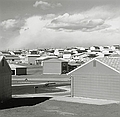| | Landscape theme: Pristine vs. Altered by man - Checklist |
1
LL/1996 |  | Robert Adams
Pikes Peak Park, Colorado Springs
1970
Gelatin silver print
5 7/8 x 6 (14.8 x 15.2 cm)
MoMA - Museum of Modern Art, New York
David H. McAlpin Fund
| 2
LL/2473 |  | Eliot Porter
Waterslide from Above, Long Canyon
1965, 21 September
Dye imbibition print
12.25 x 15.8
Amon Carter Museum
© 1990 Amon Carter Museum, Fort Worth, Texas, Bequest of the artist (P1990.58.6.9)
| 3
LL/7353 |  | Carleton E. Watkins
Trestle on Central Pacific Railroad
1868-1870
Albumen print
8 1/16 x 12 3/8 in
J. Paul Getty Museum
The J. Paul Getty Trust, Gift in memory of Leona Naef Merrill and in honor of her sister, Gladys Porterfield (94.XA.113.26)
| 4
LL/7652 |  | C.L. Weed
Mirror Lake and Reflections, Yosemite Valley, Mariposa County, California
1865
Albumen print
39.4 x 51.4 cm (15 1/2 x 20 1/4 in)
American Art Museum, Smithsonian Institution
Gift of Dr. & Mrs. Charles T. Isaacs
|
Contextual notes:
Over time within landscape photography we have seen changes in the way human activity is recorded - many photographers strive to ensure that there is no trace of humanity and that no telegraph pole, power line or road is shown. They see a world in which nature is a pristine Eden unblemished by human progress.
- This approach is in keeping with the 1865 albumen print of Mirror Lake and Reflections, Yosemite Valley, Mariposa County, California by Charles Leander Weed. He was the first person to take photographs of the Yosemite Valley and at a time when there was little human activity so it really was virgin territory.
- Many of the early topographical views of the American West were taken by survey teams and railroad photographers. Their photographs highlighted the boundless opportunities of the untouched territories to the audience in the eastern cities and encouraged them to travel west. At the same time the photographs showed the stockholders and owners of the railroads the progress that was being made. The incredibly detailed albumen print of Carleton Eugene Watkins, taken between 1866-1868, shows one of the trestles on the Canadian Pacific Railroad - here the landscape is being tamed and conquered.
- The vision of photographers such as Jim Dine, Lewis Baltz and Robert Hickman Adams in the western USA in the 1960s and 1970s was a break with the nature as grandeur that could be tamed tradition. In the seventies their approach was termed the "New Topographics" and the name was well chosen. They rejected the wilderness and showed the industrial parks, suburbs and mundane construction that were paving the land. They showed a brutalized world that had been black topped into parking lots, turned into gas stations and become an endless series of strip malls and road junctions. In the 1970 silver gelatin print by Robert Hickman Adams there is an attraction in the patterns of uncontrolled suburbs but it is the antithesis of the untouched valleys of Charles Leander Weed from a hundred years earlier.
- As color photography became accepted as an art form photojournalists like Ernst Haas adopted it and now it is widely accepted by contemporary landscape photographers such as Christopher Burkett, Robert Glenn Ketchum, Stephen Shore and Shinzo Maeda. The photograph by Eliot Porter is a return to the nostalgia for the untouched wilderness and the need to preserve it.
There are cyclical movements in the way that landscape is photographed. |
| | |

